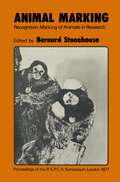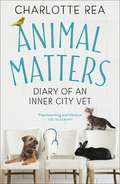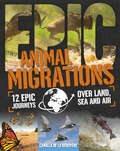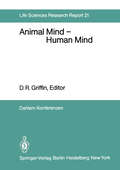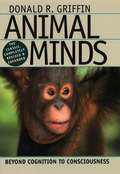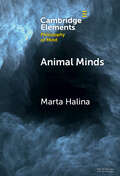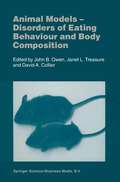- Table View
- List View
Animal Manure Recycling: Treatment and Management
by Sven G. Sommer Morten L. Christensen Thomas Schmidt Lars Stoumann JensenA rapidly changing and expanding livestock and poultry production sector is causing a range of environmental problems on local, regional and global scales. Animal Manure Recycling: Treatment and Management presents an accessible overview of environmentally friendly technologies for managing animal manure more efficiently and in a sustainable manner. The book describes the physical and chemical characteristics of animal manure and microbial processes, featuring detailed examples and case studies showing how this knowledge can be used in practice. Readers are introduced to the sustainable use of animal manure for crop fertilisation and soil amelioration. Environmentally friendly technologies for reducing emissions of ammonia, odour and the greenhouse gases nitrous oxide and methane are presented, and reduction of plant nutrient losses using separation technologies is introduced. Finally and most importantly, the book describes methods to commercialise and transfer knowledge about innovations to end-users. Topics covered include: Regulation of animal manure management Manure organic matter: characteristics and microbial transformations Greenhouse gas emissions from animal manures and technologies for their reduction Technologies and logistics for handling, transport and distribution of animal manures Bioenergy production Animal manure residue upgrading and nutrient recovery in bio-fertilisers Life cycle assessment of manure management systems Innovation in animal manure management and recycling Animal Manure Recycling: Treatment and Management presents state-of-the-art coverage of the entire animal manure chain, providing practical information for engineers, environmental consultants, academics and advanced students involved in scientific, technical and regulatory issues related to animal manure management.
Animal Manure Recycling: Treatment and Management
by Sven G. Sommer Morten L. Christensen Thomas Schmidt Lars Stoumann JensenA rapidly changing and expanding livestock and poultry production sector is causing a range of environmental problems on local, regional and global scales. Animal Manure Recycling: Treatment and Management presents an accessible overview of environmentally friendly technologies for managing animal manure more efficiently and in a sustainable manner. The book describes the physical and chemical characteristics of animal manure and microbial processes, featuring detailed examples and case studies showing how this knowledge can be used in practice. Readers are introduced to the sustainable use of animal manure for crop fertilisation and soil amelioration. Environmentally friendly technologies for reducing emissions of ammonia, odour and the greenhouse gases nitrous oxide and methane are presented, and reduction of plant nutrient losses using separation technologies is introduced. Finally and most importantly, the book describes methods to commercialise and transfer knowledge about innovations to end-users. Topics covered include: Regulation of animal manure management Manure organic matter: characteristics and microbial transformations Greenhouse gas emissions from animal manures and technologies for their reduction Technologies and logistics for handling, transport and distribution of animal manures Bioenergy production Animal manure residue upgrading and nutrient recovery in bio-fertilisers Life cycle assessment of manure management systems Innovation in animal manure management and recycling Animal Manure Recycling: Treatment and Management presents state-of-the-art coverage of the entire animal manure chain, providing practical information for engineers, environmental consultants, academics and advanced students involved in scientific, technical and regulatory issues related to animal manure management.
Animal Matters: Diary of an Inner City Vet
by Charlotte Rea'Heartwarming and hilarious' Telegraph'With as many horrifying stories as heart-warming ones, this is a fascinating look at the year in the life of a vet at a London animal charity hospital. There are some proper belly laughs as well as some insights that will truly stick with you.' - Alexandra Heminsley, GraziaAn unusual 'dalmation', a TV star with cancer, an out of control budgie. Charlotte Rea has seen them all, and more. Animal Matters is Charlotte's diary of real-life cases written during a one year of her work as a veterinary surgeon in a 24-hour inner-city London animal charity. The diary reveals the reality of working as a vet, how it can be both emotional and amusing, one minute you can be consoling an owner on the loss of their much-loved pet, the next trying to catch an escaped budgie. Charlotte mixes deeply sad moments with amusing and unimaginable ones along with more detailed accounts and reflections back on her training and the experiences she has come up against over the decade since she graduated. Throughout the book you will get to know both the animals and the people and how close the bond between us can be. Charlotte also discusses contemporary issues in veterinary medicine such as animal euthanasia, RSPCA welfare cases, mental health issues within the veterinary profession, ethical concerns around pedigree dog breeding and the laws on dangerous dogs. Animal Matters is a moving and heartwarming book about the unconditional love between animals and humans.
Animal Migration, Navigation, and Homing: Symposium Held at the University of Tübingen August 17–20, 1977 (Proceedings in Life Sciences)
by K. Schmidt-Koenig W. T. KeetonAnimal Migrations: Animal Migrations (Epic! #3)
by Camilla De La BedoyereEpic: Animal Migrations focuses on 12 of the most remarkable animal migrations in the world, from the monarch butterfly, which weighs no more than a pea, but journeys all the way across North America each year, to the leatherback turtle, which migrates across an entire ocean to breed. The book details the timespan and location of each migration, the reasons involved and the method used. A timeline on every spread gives the time frame for each migration, and what happens when. Additional background information to each animal is also provided, including the wildebeest, the Arctic tern, the caribou, the gray whale, the European eel, the Sockeye salmon, the dragonfly, the straw-coloured fruit bat, zooplankton and the Christmas Island red crab. Epic: Animal Migrations also looks at the science behind each migration, and how the animals know where and when to go. Infographic elements on each spread present information in a simple and highly visual way. Clear, concise text and a bright, appealing design make the book the perfect resource for project work on habitats, adaptation, genetics and inheritance, or simply a great leisure read, for children aged 9 and above.For more epic events, try reading the other titles in the Epic series: Battles, Empires and Explorers.
The Animal Mind: An Introduction to the Philosophy of Animal Cognition
by Kristin AndrewsThe study of animal cognition raises profound questions about the minds of animals and philosophy of mind itself. Aristotle argued that humans are the only animal to laugh, but in recent experiments rats have also been shown to laugh. In other experiments, dogs have been shown to respond appropriately to over two hundred words in human language. In this introduction to the philosophy of animal minds Kristin Andrews introduces and assesses the essential topics, problems and debates as they cut across animal cognition and philosophy of mind. She addresses the following key topics: what is cognition, and what is it to have a mind? What questions should we ask to determine whether behaviour has a cognitive basis? the science of animal minds explained: ethology, behaviourist psychology, and cognitive ethology rationality in animals animal consciousness: what does research into pain and the emotions reveal? What can empirical evidence about animal behaviour tell us about philosophical theories of consciousness? does animal cognition involve belief and concepts; do animals have a ‘Language of Thought’? animal communication other minds: do animals attribute ‘mindedness’ to other creatures? moral reasoning and ethical behaviour in animals animal cognition and memory. Extensive use of empirical examples and case studies is made throughout the book. These include Cheney and Seyfarth’s ververt monkey research, Thorndike’s cat puzzle boxes, Jensen’s research into humans and chimpanzees and the ultimatum game, Pankseep and Burgdorf’s research on rat laughter, and Clayton and Emery’s research on memory in scrub-jays. Additional features such as chapter summaries, annotated further reading and a glossary make this an indispensable introduction to those teaching philosophy of mind, animal cognition. It will also be an excellent resource for those in fields such as ethology, biology and psychology.
The Animal Mind: An Introduction to the Philosophy of Animal Cognition
by Kristin AndrewsThe study of animal cognition raises profound questions about the minds of animals and philosophy of mind itself. Aristotle argued that humans are the only animal to laugh, but in recent experiments rats have also been shown to laugh. In other experiments, dogs have been shown to respond appropriately to over two hundred words in human language. In this introduction to the philosophy of animal minds Kristin Andrews introduces and assesses the essential topics, problems and debates as they cut across animal cognition and philosophy of mind. She addresses the following key topics: what is cognition, and what is it to have a mind? What questions should we ask to determine whether behaviour has a cognitive basis? the science of animal minds explained: ethology, behaviourist psychology, and cognitive ethology rationality in animals animal consciousness: what does research into pain and the emotions reveal? What can empirical evidence about animal behaviour tell us about philosophical theories of consciousness? does animal cognition involve belief and concepts; do animals have a ‘Language of Thought’? animal communication other minds: do animals attribute ‘mindedness’ to other creatures? moral reasoning and ethical behaviour in animals animal cognition and memory. Extensive use of empirical examples and case studies is made throughout the book. These include Cheney and Seyfarth’s ververt monkey research, Thorndike’s cat puzzle boxes, Jensen’s research into humans and chimpanzees and the ultimatum game, Pankseep and Burgdorf’s research on rat laughter, and Clayton and Emery’s research on memory in scrub-jays. Additional features such as chapter summaries, annotated further reading and a glossary make this an indispensable introduction to those teaching philosophy of mind, animal cognition. It will also be an excellent resource for those in fields such as ethology, biology and psychology.
The Animal Mind: An Introduction to the Philosophy of Animal Cognition
by Kristin AndrewsThe philosophy of animal minds addresses profound questions about the nature of mind and the relationships between humans and other animals. In this fully revised and updated introductory text, Kristin Andrews introduces and assesses the essential topics, problems, and debates as they cut across animal cognition and philosophy of mind, citing historical and cutting-edge empirical data and case studies throughout. The second edition includes a new chapter on animal culture. There are also new sections on the evolution of consciousness and tool use in animals, as well as substantially revised sections on mental representation, belief, communication, theory of mind, animal ethics, and moral psychology. Further features such as chapter summaries, annotated further reading, and a glossary make The Animal Mind an indispensable introduction to those teaching philosophy of mind, philosophy of animal minds or animal cognition. It will also be an excellent resource for those in fields such as ethology, biology, and psychology.
The Animal Mind: An Introduction to the Philosophy of Animal Cognition
by Kristin AndrewsThe philosophy of animal minds addresses profound questions about the nature of mind and the relationships between humans and other animals. In this fully revised and updated introductory text, Kristin Andrews introduces and assesses the essential topics, problems, and debates as they cut across animal cognition and philosophy of mind, citing historical and cutting-edge empirical data and case studies throughout. The second edition includes a new chapter on animal culture. There are also new sections on the evolution of consciousness and tool use in animals, as well as substantially revised sections on mental representation, belief, communication, theory of mind, animal ethics, and moral psychology. Further features such as chapter summaries, annotated further reading, and a glossary make The Animal Mind an indispensable introduction to those teaching philosophy of mind, philosophy of animal minds or animal cognition. It will also be an excellent resource for those in fields such as ethology, biology, and psychology.
Animal Mind — Human Mind: Report of the Dahlem Workshop on Animal Mind — Human Mind, Berlin 1981, March 22–27 (Dahlem Workshop Report #21)
by M. Dawkins W. Kintsch H. J. Neville R. M. Seyfarth D. R. Griffin J. F. Bennett D. Dörner S. A. Hillyard B. K. Hölldobler H. S. Markl P. R. Marler D. Premackthe oleic acid on a live and wriggling sister or mother and refrain from evicting her from our hive. But does the occur rence of unintelligent behavior suffice to demonstrate the total absence of mental experience under any circumstances? Ethologists from some distant galaxy could easily discern ex amples of stupid and maladaptive behavior in our own species. But do instances of human stupidity prove that none of us is ever consciously aware of what he is dOing? No available evi dence compels us to believe that insects, or any other animals, experience any sort of consciousness, or intentionally plan any of their behavior. But neither are we compelled to believe the contrary. In areas where data are few and of limited rel evance, dogmatic negativity can easily limit what scientists even try to investigate, and thus perhaps delay or prevent im portant insights and discoveries. Many of the participants agreed that a good starting point would be to consider what we know of our own thinking, subjec tive feelings, and consciousness, and then move on to inquire whether other species experience anything similar. Such an ap proach was once considered fallaciously anthropomorphic. But it seems now to be widely if not universally recognized that this is a serious objection only if one has already assumed in advance that conscious thinking is uniquely human, and the accu sation of anthropomorphism is then merely a reiteration of the prior conviction.
Animal Minds: Beyond Cognition to Consciousness
by Donald R. GriffinIn Animal Minds, Donald R. Griffin takes us on a guided tour of the recent explosion of scientific research on animal mentality. Are animals consciously aware of anything, or are they merely living machines, incapable of conscious thoughts or emotional feelings? How can we tell? Such questions have long fascinated Griffin, who has been a pioneer at the forefront of research in animal cognition for decades, and is recognized as one of the leading behavioral ecologists of the twentieth century. With this new edition of his classic book, which he has completely revised and updated, Griffin moves beyond considerations of animal cognition to argue that scientists can and should investigate questions of animal consciousness. Using examples from studies of species ranging from chimpanzees and dolphins to birds and honeybees, he demonstrates how communication among animals can serve as a "window" into what animals think and feel, just as human speech and nonverbal communication tell us most of what we know about the thoughts and feelings of other people. Even when they don't communicate about it, animals respond with sometimes surprising versatility to new situations for which neither their genes nor their previous experiences have prepared them, and Griffin discusses what these behaviors can tell us about animal minds. He also reviews the latest research in cognitive neuroscience, which has revealed startling similarities in the neural mechanisms underlying brain functioning in both humans and other animals. Finally, in four chapters greatly expanded for this edition, Griffin considers the latest scientific research on animal consciousness, pro and con, and explores its profound philosophical and ethical implications.
Animal Minds: Beyond Cognition to Consciousness
by Donald R. GriffinIn Animal Minds, Donald R. Griffin takes us on a guided tour of the recent explosion of scientific research on animal mentality. Are animals consciously aware of anything, or are they merely living machines, incapable of conscious thoughts or emotional feelings? How can we tell? Such questions have long fascinated Griffin, who has been a pioneer at the forefront of research in animal cognition for decades, and is recognized as one of the leading behavioral ecologists of the twentieth century. With this new edition of his classic book, which he has completely revised and updated, Griffin moves beyond considerations of animal cognition to argue that scientists can and should investigate questions of animal consciousness. Using examples from studies of species ranging from chimpanzees and dolphins to birds and honeybees, he demonstrates how communication among animals can serve as a "window" into what animals think and feel, just as human speech and nonverbal communication tell us most of what we know about the thoughts and feelings of other people. Even when they don't communicate about it, animals respond with sometimes surprising versatility to new situations for which neither their genes nor their previous experiences have prepared them, and Griffin discusses what these behaviors can tell us about animal minds. He also reviews the latest research in cognitive neuroscience, which has revealed startling similarities in the neural mechanisms underlying brain functioning in both humans and other animals. Finally, in four chapters greatly expanded for this edition, Griffin considers the latest scientific research on animal consciousness, pro and con, and explores its profound philosophical and ethical implications.
Animal Minds: Beyond Cognition to Consciousness
by Donald R. GriffinIn Animal Minds, Donald R. Griffin takes us on a guided tour of the recent explosion of scientific research on animal mentality. Are animals consciously aware of anything, or are they merely living machines, incapable of conscious thoughts or emotional feelings? How can we tell? Such questions have long fascinated Griffin, who has been a pioneer at the forefront of research in animal cognition for decades, and is recognized as one of the leading behavioral ecologists of the twentieth century. With this new edition of his classic book, which he has completely revised and updated, Griffin moves beyond considerations of animal cognition to argue that scientists can and should investigate questions of animal consciousness. Using examples from studies of species ranging from chimpanzees and dolphins to birds and honeybees, he demonstrates how communication among animals can serve as a "window" into what animals think and feel, just as human speech and nonverbal communication tell us most of what we know about the thoughts and feelings of other people. Even when they don't communicate about it, animals respond with sometimes surprising versatility to new situations for which neither their genes nor their previous experiences have prepared them, and Griffin discusses what these behaviors can tell us about animal minds. He also reviews the latest research in cognitive neuroscience, which has revealed startling similarities in the neural mechanisms underlying brain functioning in both humans and other animals. Finally, in four chapters greatly expanded for this edition, Griffin considers the latest scientific research on animal consciousness, pro and con, and explores its profound philosophical and ethical implications.
Animal Minds: Beyond Cognition to Consciousness
by Donald R. GriffinIn Animal Minds, Donald R. Griffin takes us on a guided tour of the recent explosion of scientific research on animal mentality. Are animals consciously aware of anything, or are they merely living machines, incapable of conscious thoughts or emotional feelings? How can we tell? Such questions have long fascinated Griffin, who has been a pioneer at the forefront of research in animal cognition for decades, and is recognized as one of the leading behavioral ecologists of the twentieth century. With this new edition of his classic book, which he has completely revised and updated, Griffin moves beyond considerations of animal cognition to argue that scientists can and should investigate questions of animal consciousness. Using examples from studies of species ranging from chimpanzees and dolphins to birds and honeybees, he demonstrates how communication among animals can serve as a "window" into what animals think and feel, just as human speech and nonverbal communication tell us most of what we know about the thoughts and feelings of other people. Even when they don't communicate about it, animals respond with sometimes surprising versatility to new situations for which neither their genes nor their previous experiences have prepared them, and Griffin discusses what these behaviors can tell us about animal minds. He also reviews the latest research in cognitive neuroscience, which has revealed startling similarities in the neural mechanisms underlying brain functioning in both humans and other animals. Finally, in four chapters greatly expanded for this edition, Griffin considers the latest scientific research on animal consciousness, pro and con, and explores its profound philosophical and ethical implications.
Animal Minds: Beyond Cognition to Consciousness
by Donald R. GriffinIn Animal Minds, Donald R. Griffin takes us on a guided tour of the recent explosion of scientific research on animal mentality. Are animals consciously aware of anything, or are they merely living machines, incapable of conscious thoughts or emotional feelings? How can we tell? Such questions have long fascinated Griffin, who has been a pioneer at the forefront of research in animal cognition for decades, and is recognized as one of the leading behavioral ecologists of the twentieth century. With this new edition of his classic book, which he has completely revised and updated, Griffin moves beyond considerations of animal cognition to argue that scientists can and should investigate questions of animal consciousness. Using examples from studies of species ranging from chimpanzees and dolphins to birds and honeybees, he demonstrates how communication among animals can serve as a "window" into what animals think and feel, just as human speech and nonverbal communication tell us most of what we know about the thoughts and feelings of other people. Even when they don't communicate about it, animals respond with sometimes surprising versatility to new situations for which neither their genes nor their previous experiences have prepared them, and Griffin discusses what these behaviors can tell us about animal minds. He also reviews the latest research in cognitive neuroscience, which has revealed startling similarities in the neural mechanisms underlying brain functioning in both humans and other animals. Finally, in four chapters greatly expanded for this edition, Griffin considers the latest scientific research on animal consciousness, pro and con, and explores its profound philosophical and ethical implications.
Animal Minds: Beyond Cognition to Consciousness
by Donald R. GriffinIn Animal Minds, Donald R. Griffin takes us on a guided tour of the recent explosion of scientific research on animal mentality. Are animals consciously aware of anything, or are they merely living machines, incapable of conscious thoughts or emotional feelings? How can we tell? Such questions have long fascinated Griffin, who has been a pioneer at the forefront of research in animal cognition for decades, and is recognized as one of the leading behavioral ecologists of the twentieth century. With this new edition of his classic book, which he has completely revised and updated, Griffin moves beyond considerations of animal cognition to argue that scientists can and should investigate questions of animal consciousness. Using examples from studies of species ranging from chimpanzees and dolphins to birds and honeybees, he demonstrates how communication among animals can serve as a "window" into what animals think and feel, just as human speech and nonverbal communication tell us most of what we know about the thoughts and feelings of other people. Even when they don't communicate about it, animals respond with sometimes surprising versatility to new situations for which neither their genes nor their previous experiences have prepared them, and Griffin discusses what these behaviors can tell us about animal minds. He also reviews the latest research in cognitive neuroscience, which has revealed startling similarities in the neural mechanisms underlying brain functioning in both humans and other animals. Finally, in four chapters greatly expanded for this edition, Griffin considers the latest scientific research on animal consciousness, pro and con, and explores its profound philosophical and ethical implications.
Animal Minds (Elements in Philosophy of Mind)
by null Marta HalinaAnimal minds are complex and diverse, making them difficult to study. This Element focuses on a question that has received much attention in the field of comparative cognition: 'Do animals reason about unobservable variables like force and mental states?' The Element shows how researchers design studies and gather evidence to address this question. Despite the many virtues of current methods, hypotheses in comparative cognition are often underdetermined by the empirical evidence. Given this, philosophers and scientists have recently called for additional behavioral constraints on theorizing in the field. The Element endorses this proposal (known as 'signature testing'), while also arguing that studies on animal minds would benefit from drawing more heavily on neuroscience and biology.
Animal Minds in Medieval Latin Philosophy: A Sourcebook from Augustine to Wodeham (Studies in the History of Philosophy of Mind #27)
by Anselm OelzeThis sourcebook explores how the Middle Ages dealt with questions related to the mental life of creatures great and small. It makes accessible a wide range of key Latin texts from the fourth to the fourteenth century in fresh English translations. Specialists and non-specialists alike will find many surprising insights in this comprehensive collection of sources on the medieval philosophy of animal minds. The book’s structure follows the distinction between the different aspects of the mental. The author has organized the material in three main parts: cognition, emotions, and volition. Each part contains translations of texts by different medieval thinkers. The philosophers chosen include well-known figures like Augustine, Albert the Great, and Thomas Aquinas. The collection also profiles the work of less studied thinkers like John Blund, (Pseudo-)Peter of Spain, and Peter of Abano. In addition, among those featured are several translated here into English for the first time. Each text comes with a short introduction to the philosopher, the context, and the main arguments of the text plus a section with bibliographical information and recommendations for further reading. A general introduction to the entire volume presents the basic concepts and questions of the philosophy of animal minds and explains how the medieval discussion relates to the contemporary debate. This sourcebook is valuable for anyone interested in the history of philosophy, especially medieval philosophy of mind. It will also appeal to scholars and students from other fields, such as psychology, theology, and cultural studies.
Animal Models: Disorders of Eating Behaviour and Body Composition
by David A. Collier Janet L. Treasure John B. OwenThe book aims to review knowledge on the disorders of eating behaviour and body composition in some of the non-primate higher animals and to relate these to similar conditions in humans. With advances in understanding the nature of these disorders and their biological basis, it seems timely to assess what cross-species comparisons can tell us about the general underlying factors at work. This may also help to delineate what may be a general biological basis that humans share with their higher animal comrade species and what may distinguish human from non-human, particularly in a cultural context. This could help in combating better the problems of these conditions in the animal species as well as in man and in suggesting well-based preventive measures. As far as people are concerned the last two decades of the 20th century have shown a significant increase in obesity in the richer countries, particularly the USA (Table 1). Possibly associated with the obesity boom, there is an increasing awareness of other disorders of eating behaviour and body composition. These range from anorexia nervosa, at the other end of body composition to obesity, to others, such as bulimia, with more variable effects on body composition.
Animal Models and Human Reproduction: Cell And Molecular Approaches With Reference To Human Reproduction
by Heide Schatten Gheorghe M. ConstantinescuOur knowledge of reproductive biology has increased enormously in recent years on cellular, molecular, and genetic levels, leading to significant breakthroughs that have directly benefitted in vitro fertilization (IVF) and other assisted reproductive technologies (ART) in humans and animal systems. Animal Models and Human Reproduction presents a comprehensive reference that reflects the latest scientific research being done in human reproductive biology utilizing domestic animal models. Chapters on canine, equine, cow, pig, frog, and mouse models of reproduction reflect frontier research in placental biology, ovarian function and fertility, non-coding RNAs in gametogenesis, oocyte and embryo metabolism, fertilization, cryopreservation, signal transduction pathways, chromatin dynamics, epigenetics, reproductive aging, and inflammation. Chapters on non-human primate models also highlight recent advancements into such issues as human in vitro fertilization (IVF) and assisted reproductive technologies (ART). This book offers animal scientists, reproductive biology scientists, clinicians and practitioners, invaluable insights into a wide range of issues at the forefront of human reproductive health.
Animal Models and Human Reproduction: Cell And Molecular Approaches With Reference To Human Reproduction
by Heide Schatten Gheorghe M. ConstantinescuOur knowledge of reproductive biology has increased enormously in recent years on cellular, molecular, and genetic levels, leading to significant breakthroughs that have directly benefitted in vitro fertilization (IVF) and other assisted reproductive technologies (ART) in humans and animal systems. Animal Models and Human Reproduction presents a comprehensive reference that reflects the latest scientific research being done in human reproductive biology utilizing domestic animal models. Chapters on canine, equine, cow, pig, frog, and mouse models of reproduction reflect frontier research in placental biology, ovarian function and fertility, non-coding RNAs in gametogenesis, oocyte and embryo metabolism, fertilization, cryopreservation, signal transduction pathways, chromatin dynamics, epigenetics, reproductive aging, and inflammation. Chapters on non-human primate models also highlight recent advancements into such issues as human in vitro fertilization (IVF) and assisted reproductive technologies (ART). This book offers animal scientists, reproductive biology scientists, clinicians and practitioners, invaluable insights into a wide range of issues at the forefront of human reproductive health.
Animal Models for Endometriosis: Evolution, Utility and Clinical Relevance (Advances in Anatomy, Embryology and Cell Biology #232)
by Kathy L. Sharpe-TimmsThis new volume of our successful book series Advances in Anatomy, Embryology and Cell Biology focuses on the need for and use of animal models when studying endometriosis. Covering models ranging from rodents to baboons, it explores novel mechanisms involved in the pathophysiology of endometriosis. Topics range from the role of miRNAs and environmental endocrine disrupters to pain and endometriosis-associated subfertility.Estimated to affect up to 10% of women, endometriosis is a widespread and in some cases debilitating disease. While studies on the pathophysiology of the disease and the development of treatments for endometriosis-associated subfertility are called for, acquiring appropriate tissues from women with and without endometriosis in combination with physiologically relevant in vitro and in vivo laboratory models is an essential aspect. However, control subjects with similar ages, living environments and medical histories, besides endometriosis, are hard to find and attaining suitable human reproductive tissues is linked to an ongoing ethical discussion, especially when studying embryos. Laboratory models like rodent and monkey models are therefore needed to fill the research gap and support hypothesis-driven, randomized, controlled experimental design studies. In this book we highlight the latest developments and findings in endometriosis research using animal models. The book was written for scientists, physicians and medical students working in the field of reproductive science, and for women with endometriosis.
Animal Models for Human Cancer: Discovery and Development of Novel Therapeutics (Methods and Principles in Medicinal Chemistry #69)
by Raimund Mannhold Hugo Kubinyi Gerd FolkersBased on results from the past ten years, this ready reference systematically describes how to prepare, carry out, and evaluate animal studies for cancer therapies, addressing the widely recognized lack of reliable and reproducible results. Following a short historical introduction and a discussion of the ethics surrounding animal experiments, the book describes correct study design as well as the handling and housing of animals. It then goes on to describe the animal models available for different cancer types, from natural cancer models in mice and dogs to humanized animals. An evaluation of previously unpublished long-term data from the Swiss canine and feline cancer registry is also included. The final part of the book reviews the lessons learned over the last decade on how to interpret data from animal studies for improving human therapy and gives recommendations for future drug development.
Animal Models for Human Cancer: Discovery and Development of Novel Therapeutics (Methods and Principles in Medicinal Chemistry)
by Raimund Mannhold Hugo Kubinyi Gerd FolkersBased on results from the past ten years, this ready reference systematically describes how to prepare, carry out, and evaluate animal studies for cancer therapies, addressing the widely recognized lack of reliable and reproducible results. Following a short historical introduction and a discussion of the ethics surrounding animal experiments, the book describes correct study design as well as the handling and housing of animals. It then goes on to describe the animal models available for different cancer types, from natural cancer models in mice and dogs to humanized animals. An evaluation of previously unpublished long-term data from the Swiss canine and feline cancer registry is also included. The final part of the book reviews the lessons learned over the last decade on how to interpret data from animal studies for improving human therapy and gives recommendations for future drug development.

